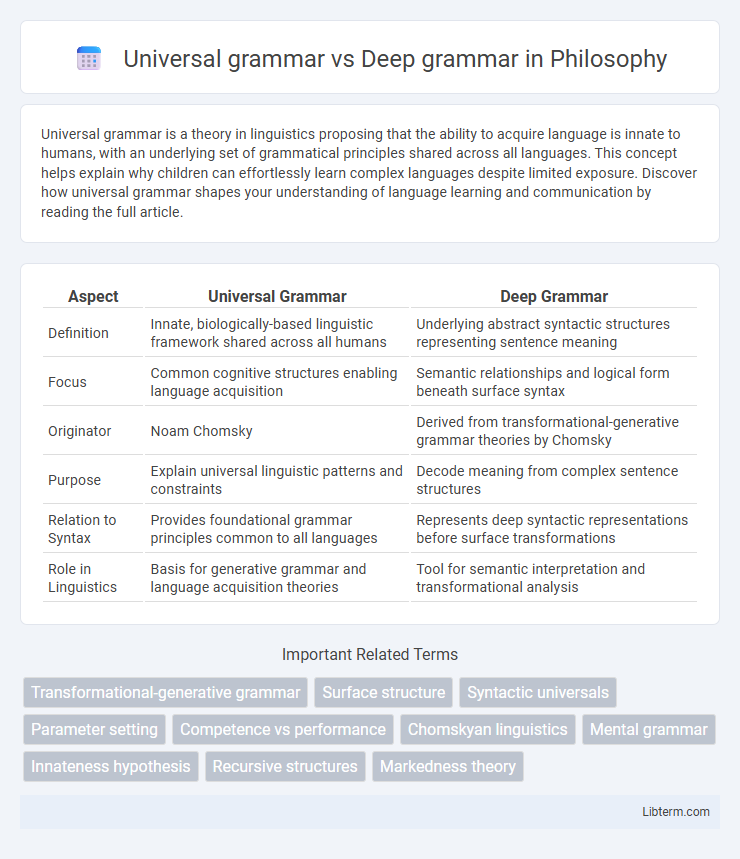Universal grammar is a theory in linguistics proposing that the ability to acquire language is innate to humans, with an underlying set of grammatical principles shared across all languages. This concept helps explain why children can effortlessly learn complex languages despite limited exposure. Discover how universal grammar shapes your understanding of language learning and communication by reading the full article.
Table of Comparison
| Aspect | Universal Grammar | Deep Grammar |
|---|---|---|
| Definition | Innate, biologically-based linguistic framework shared across all humans | Underlying abstract syntactic structures representing sentence meaning |
| Focus | Common cognitive structures enabling language acquisition | Semantic relationships and logical form beneath surface syntax |
| Originator | Noam Chomsky | Derived from transformational-generative grammar theories by Chomsky |
| Purpose | Explain universal linguistic patterns and constraints | Decode meaning from complex sentence structures |
| Relation to Syntax | Provides foundational grammar principles common to all languages | Represents deep syntactic representations before surface transformations |
| Role in Linguistics | Basis for generative grammar and language acquisition theories | Tool for semantic interpretation and transformational analysis |
Introduction to Universal Grammar and Deep Grammar
Universal Grammar (UG) is a linguistic theory proposed by Noam Chomsky suggesting that the ability to acquire language is innate to humans, characterized by a set of grammatical principles shared across all languages. Deep Grammar refers to the underlying syntactic structures and abstract rules that govern sentence formation beyond surface variations, revealing core language patterns. Understanding Universal Grammar and Deep Grammar aids in exploring the cognitive foundations of language acquisition and syntactic representation.
The Origins and Theoretical Foundations
Universal Grammar, rooted in Noam Chomsky's theory, posits an innate set of linguistic principles hardwired into the human brain, enabling language acquisition across diverse cultures. Deep Grammar emphasizes the underlying abstract structures and cognitive processes that govern language beyond surface syntax, focusing on how meaning is constructed and understood. Both frameworks explore the origins of language through theoretical foundations that bridge cognitive science, linguistics, and psychology, with Universal Grammar stressing biological predisposition and Deep Grammar highlighting semantic complexity.
Key Principles of Universal Grammar
Universal Grammar (UG) posits innate linguistic principles common to all human languages, such as recursion, syntactic structure, and parameter setting, which enable language acquisition. UG emphasizes a preset mental framework guiding grammatical development, contrasting with Deep Grammar's focus on underlying semantic and pragmatic content. Key principles of Universal Grammar include the innateness hypothesis, modularity of language faculties, and the notion of universal syntactic rules shared across diverse languages.
Understanding Deep Grammar: Core Concepts
Deep grammar explores the underlying principles governing sentence structure and meaning beyond surface forms, emphasizing the mental representation of syntax and semantics. It focuses on universal cognitive mechanisms that shape language acquisition and processing, contrasting with Universal Grammar's innate set of linguistic rules. Core concepts include phrase structure rules, transformations, and the hierarchical nature of syntactic constituents essential for parsing complex linguistic input.
Major Differences Between Universal and Deep Grammar
Universal grammar proposes an innate set of grammatical principles shared across all human languages, emphasizing abstract, language-independent rules embedded in the human mind. Deep grammar, on the other hand, refers to the underlying syntactic structure unique to each language, capturing language-specific rules and representations beyond surface variations. The major differences lie in universal grammar's focus on cognitive universality versus deep grammar's concentration on detailed, language-specific syntactic patterns and hierarchical representations.
Linguistic Evidence Supporting Universal Grammar
Linguistic evidence supporting Universal Grammar (UG) includes the presence of innate syntactic structures shared across diverse languages, such as the consistent use of hierarchical sentence organization and recursion found in all human languages. Studies of language acquisition reveal that children rapidly acquire complex grammatical rules without explicit instruction, indicating an inherent, universal cognitive framework for language. Cross-linguistic research further identifies universal constraints on word order and phrase structure, reinforcing the argument that UG underlies the deep, abstract grammar governing all human languages.
Criticisms and Limitations of Deep Grammar
Deep Grammar faces criticism for its complexity and limited empirical validation compared to Universal Grammar, which is widely recognized in linguistics. The intricate rules and representations in Deep Grammar often lead to challenges in practical application and computational implementation. Unlike Universal Grammar's broad theoretical framework supported by cross-linguistic evidence, Deep Grammar's specificity can result in reduced adaptability and overfitting to particular language data.
Applications in Language Acquisition and Learning
Universal grammar theories emphasize innate, biological structures guiding language acquisition, influencing pedagogical approaches that prioritize natural exposure and subconscious learning. Deep grammar frameworks analyze underlying syntactic and semantic patterns, aiding computational linguistics and advanced language processing applications like machine translation and language modeling. In language learning, integrating universal grammar insights with deep grammar analysis enhances curriculum design by addressing both innate linguistic capacity and structural complexities.
Universal Grammar and Deep Grammar in Computational Linguistics
Universal Grammar in computational linguistics refers to the innate, abstract set of grammatical rules and principles shared across all human languages, serving as a foundational framework for natural language processing models. Deep Grammar focuses on the detailed, language-specific syntactic and semantic rules that computational systems use to parse and generate complex sentence structures accurately. Understanding Universal Grammar enables the development of more generalized and adaptable language models, while Deep Grammar enhances their precision in handling language-specific nuances and complexities.
Future Perspectives and Ongoing Debates
Future perspectives on Universal Grammar emphasize its adaptability in integrating insights from cognitive neuroscience and artificial intelligence to better understand innate linguistic structures. Ongoing debates contrast Universal Grammar's focus on fixed, biologically endowed rules with Deep Grammar approaches that exploit deep learning algorithms to model language acquisition and processing. Emerging research explores hybrid models combining Universal Grammar principles with data-driven Deep Grammar techniques to enhance natural language understanding and generation.
Universal grammar Infographic

 libterm.com
libterm.com